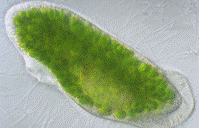Papers in the Biological Sciences
Document Type
Article
Date of this Version
2012
Citation
Applied and Environmental Microbiology p. 7931–7938, November 2012 Volume 78 Number 22
Abstract
Extremely thermoacidophilic microbes, such as Sulfolobus solfataricus, are strict chemoheterotrophs despite their geologic niche. To clarify their ecophysiology, the overlapping roles of endoglucanases and carbohydrate transporters were examined during growth on soluble cellodextrins as the sole carbon and energy source. Strain-specific differences in genome structure implied a unique role for one of three endogenous endoglucanases. Plasmid-based endoglucanase expression promoted the consumption of oligosaccharides, including cellohexaose (G6) through cellonanaose (G9). Protein transporters required for cellodextrin uptake were identified through
mutagenesis and complementation of an ABC transporter cassette, including a putative oligosaccharide binding protein. In addition, ablation of the binding protein compromised growth on glucose and alpha-linked oligosaccharides while inactivation of a previously described glucose transporter had no apparent impact. These data demonstrate that S. solfataricus employs a redundant mechanism for soluble cellodextrin catabolism having both substrate uptake and extracytoplasmic hydrolytic components.


Comments
Copyright © 2012, American Society for Microbiology. All Rights Reserved.